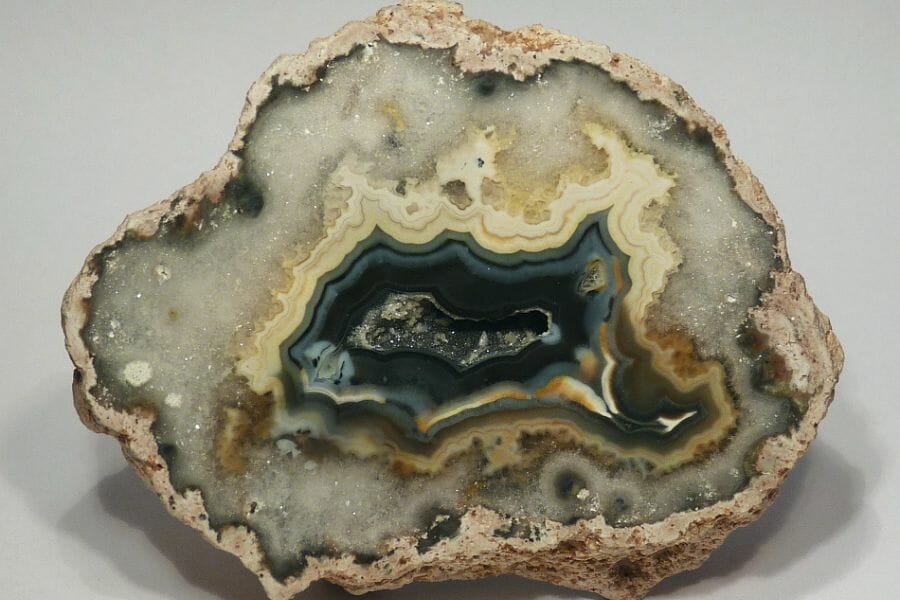Geodes are like nature’s surprise eggs, filled with sparkling crystals inside a plain-looking rock. Our state is a treasure trove for these hidden gems, with its many different landscapes that make it perfect for rock hounds.
If you’re itching to crack open your own crystal-filled wonder, you’re in the right place!
This article will show you the best spots in our state to find geodes. We’ll also share some handy tips to make your geode hunting adventure a success.
So grab your hammer and get ready to discover the beauty hiding in ordinary-looking rocks all around this state!
How Geodes From Here
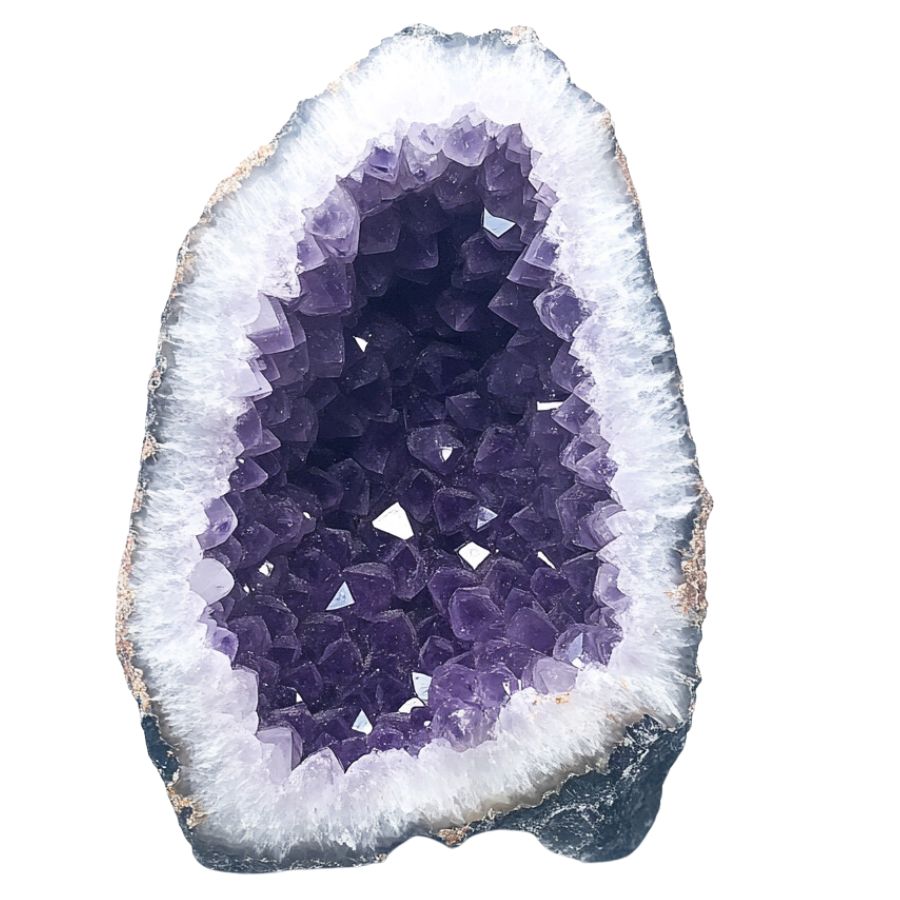
Geodes form when bubbles in volcanic rocks or spaces in sedimentary rocks get filled with minerals over time.
First, water rich in minerals like quartz or calcite seeps into the hollow space. As the water evaporates, it leaves behind the minerals, which slowly build up layer by layer.
Eventually, these minerals create a crystal lining inside the geode. The outer shell stays rough, while the inside becomes a sparkling treasure.
The process can take thousands, even millions, of years, making each geode a unique and beautiful time capsule of Earth’s natural forces.
The Types Of Geodes Found in the US
There are many fascinating varieties of geodes that can be found across the United States, including in our own state. Each type is distinctly beautiful and intriguing:
Amethyst Geode
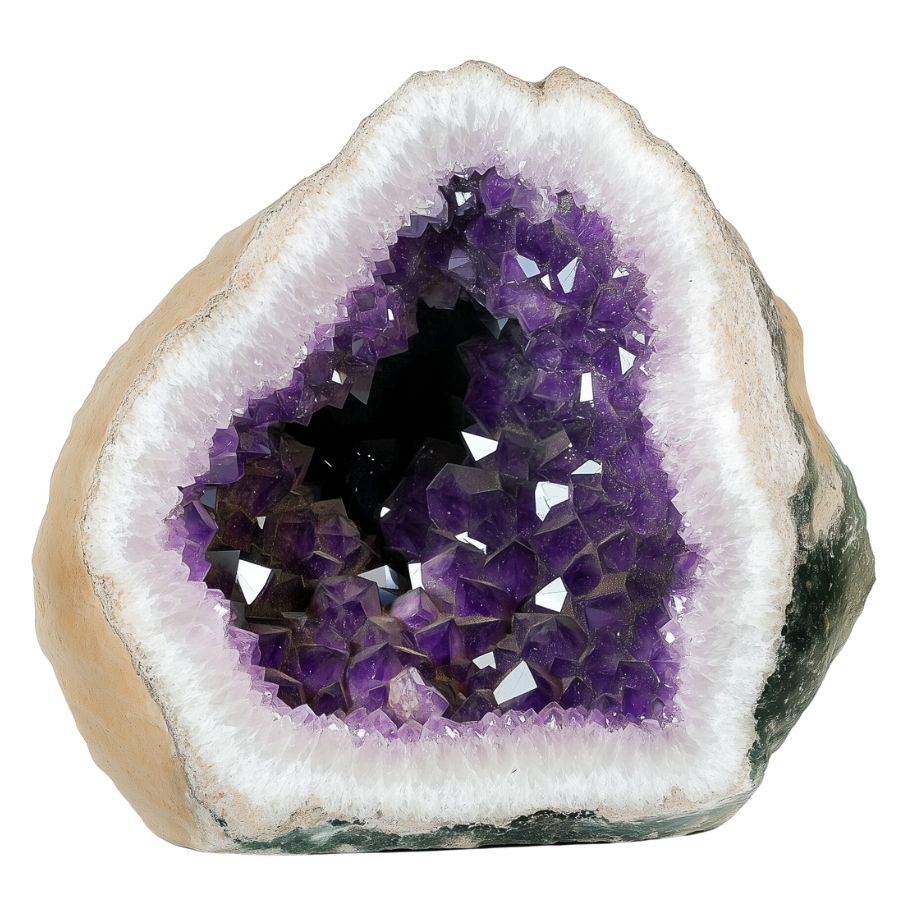
Amethyst geodes look plain on the outside, like a potato. But crack them open, and you’ll find stunning purple crystals. These crystals can be light lavender or deep purple.
The structure of crystals inside can vary widely. Some are tiny and densely packed, creating a sparkling surface. Others form large, distinct points that jut inwards.
The color range is impressive too, from pale lilac to deep royal purple. Some amethyst geodes develop unique features. “Stalactites” of amethyst might hang from the top.
In rare cases, you might find a water bubble trapped inside, a remnant from the geode’s formation millions of years ago.
Citrine Geode
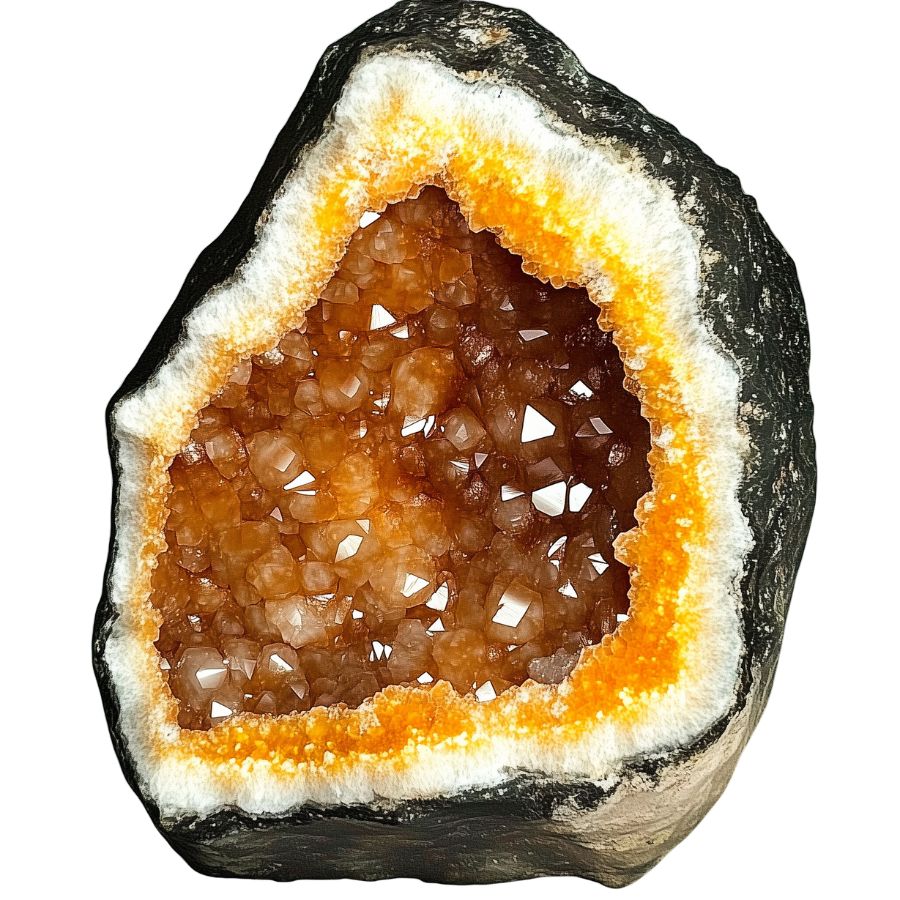
Citrine geodes are eye-catching rocks with golden yellow to orange crystals inside. They sparkle when light hits them, looking like sunshine trapped in stone. The colors come from iron mixed in with the quartz.
Unlike many gemstones, citrine’s color is often evenly distributed throughout the crystal.
Most citrine on the market isn’t natural. It’s actually heat-treated amethyst. This process turns the purple amethyst into vibrant citrine. Natural citrine is rarer and often has a more subtle color.
Pyrite Geode
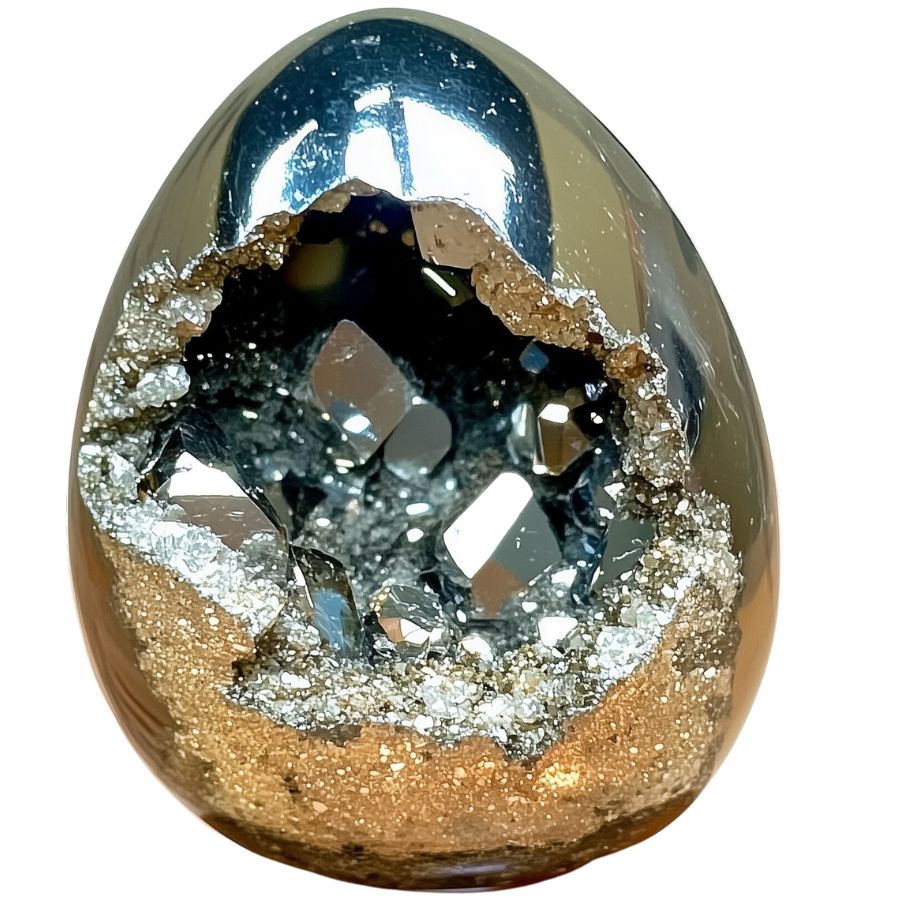
Ever cracked open a rock and found gold inside? Well, not real gold, but something that looks just like it. That’s a pyrite geode. Pyrite is called “fool’s gold” because it’s so shiny and golden.
Inside these geodes, pyrite forms in cool shapes. Sometimes it’s perfect cubes. Other times its clumps or even round balls called “pyrite suns”.
Pyrite has a fun history. People have been mixing it up with real gold for thousands of years. That’s how it got its nickname.
Selenite Geode
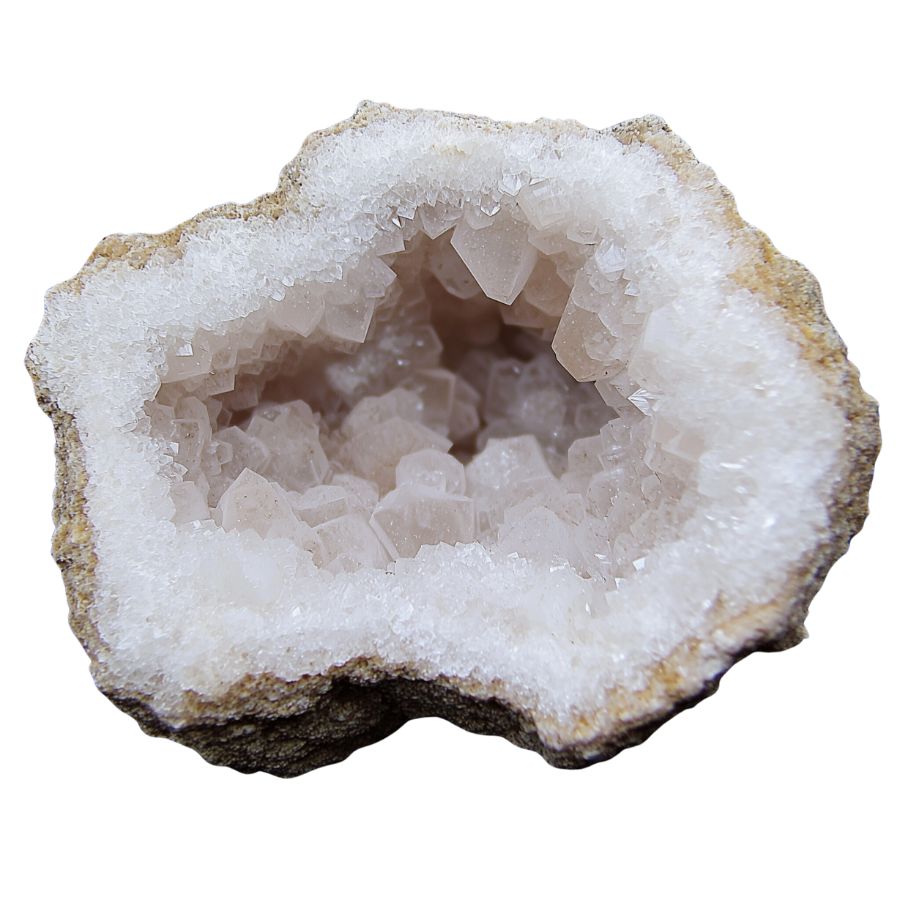
Selenite geodes stand out from the crowd. They’re white and see-through, with a glassy look. When you open one up, you’ll see crystals that look like they’re made of ice or moonlight.
Unlike harder geodes, selenite is soft. You can scratch it with your fingernail! This softness means you need to handle it carefully. But it also means selenite can be shaped into beautiful forms easily.
One cool thing about selenite is how it plays with light. Hold it up to a lamp, and you’ll see the light shine right through it. This makes selenite geodes popular for decorative lamps and light fixtures. They add a magical glow to any room.
Celestite Geode
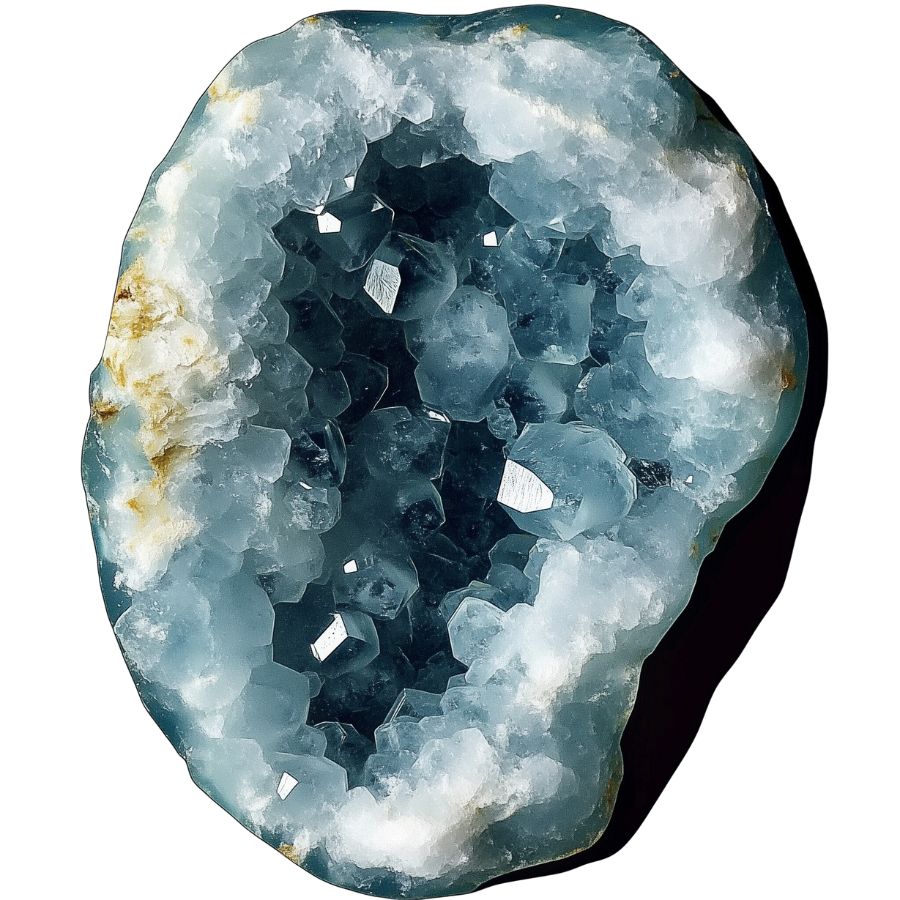
Celestite geodes are like pieces of sky trapped in rock. Their crystals are typically a delicate blue, ranging from almost colorless to deep sky blue. In rare cases, celestite can form in other colors. Pink celestite is highly prized by collectors.
One unique feature of celestite is its perfect cleavage. This means the crystals can be easily split into rhombohedral shapes.
These geodes form in a unique way. They start as nodules of a soft mineral called alabaster. Over time, this dissolves and is replaced by celestite crystals. Some celestite geodes are huge, like the famous Crystal Cave in Ohio.
Celestite isn’t just pretty to look at. It’s used to make strontium, an element with many uses. You’ll find strontium in fireworks, where it creates red colors. It’s also used in making TV screens and ceramics.
Jasper Geode
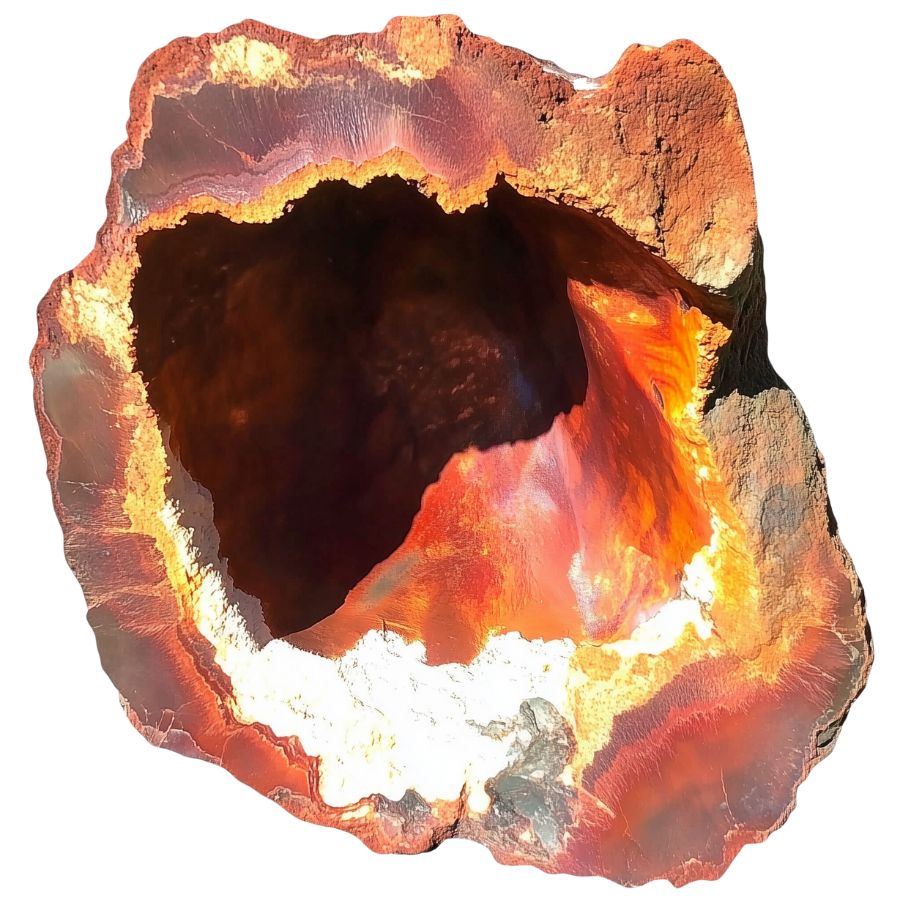
Jasper geodes are the chameleons of the mineral world. They can appear in almost any color, often with multiple hues in a single specimen. Patterns can range from solid colors to intricate swirls, bands, or spots.
One fascinating type is picture jasper. These geodes contain patterns that resemble landscapes, with “skies,” “mountains,” and “rivers” visible in the stone. Each one is like a miniature painting created by nature.
Some jasper geodes contain orbicular patterns – spherical structures that formed as the jasper solidified. These create eye-catching bull’s-eye or flower-like designs in the stone, making each piece truly one-of-a-kind.
Carnelian Geode
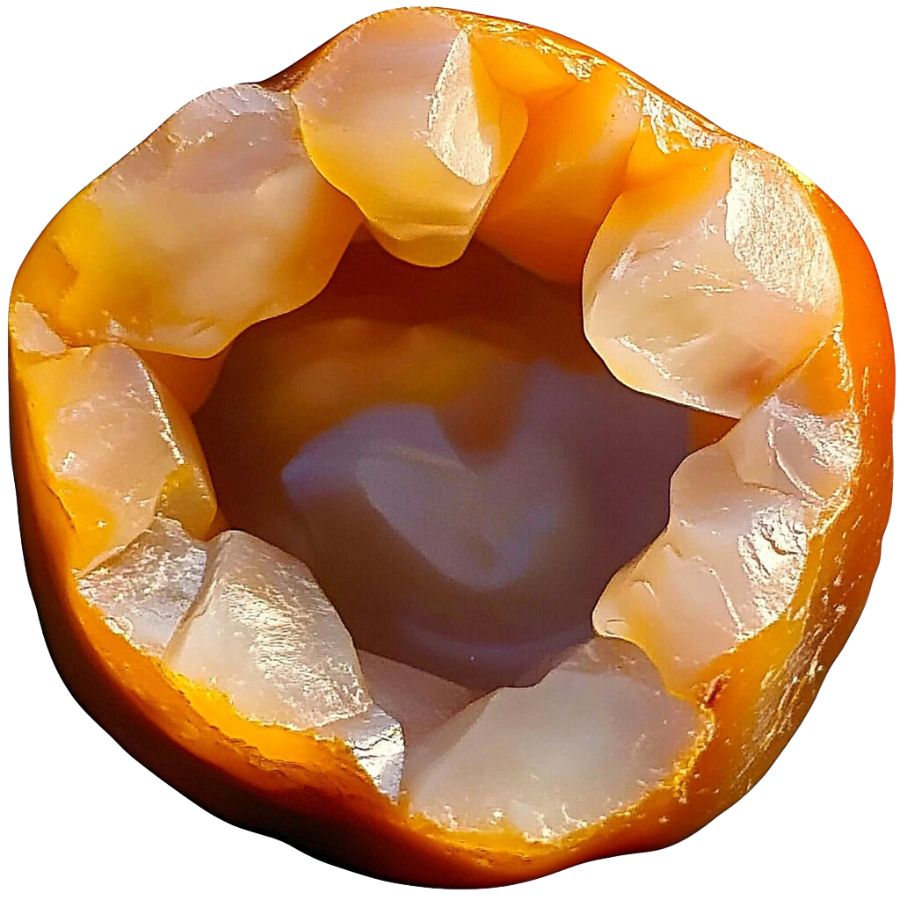
Carnelian geodes have vibrant orange to reddish-brown colors. They can be somewhat see-through, which makes them look even more interesting. The bright colors come from the iron in the stone.
These geodes stand out from other similar stones. They’re brighter than sard, which is usually darker and more brownish. And unlike agate, carnelian doesn’t have bands or stripes.
Carnelian has been popular for a long time. Ancient Egyptians and Greeks used it to make special rings. It’s tough enough for everyday jewelry.
Some people heat or dye carnelian to make its color even brighter. This makes it a favorite for both rock collectors and jewelry lovers.
Fluorite Geode
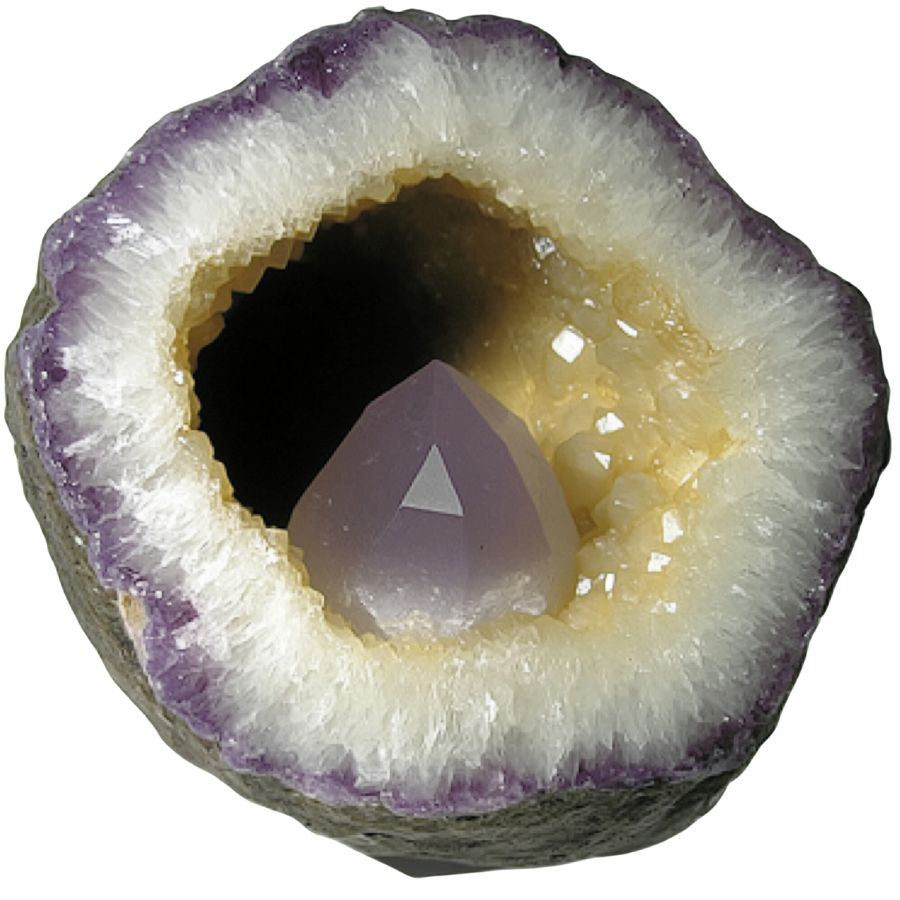
Fluorite geodes are like nature’s rainbow. They come in many colors – purple, green, blue, yellow, and sometimes even clear or black. When you open one up, you might see cube-shaped or eight-sided crystals inside.
What makes fluorite special is that you can often see more than one color in a single stone. This is different from many other geodes. Also, fluorite has a unique way of splitting when it breaks.
A cool fact: fluorite glows blue under ultraviolet light. This was first discovered back in 1852. Because of its many colors and this glowing ability, fluorite is sometimes called the “most colorful mineral in the world.”
Scolecite Geode
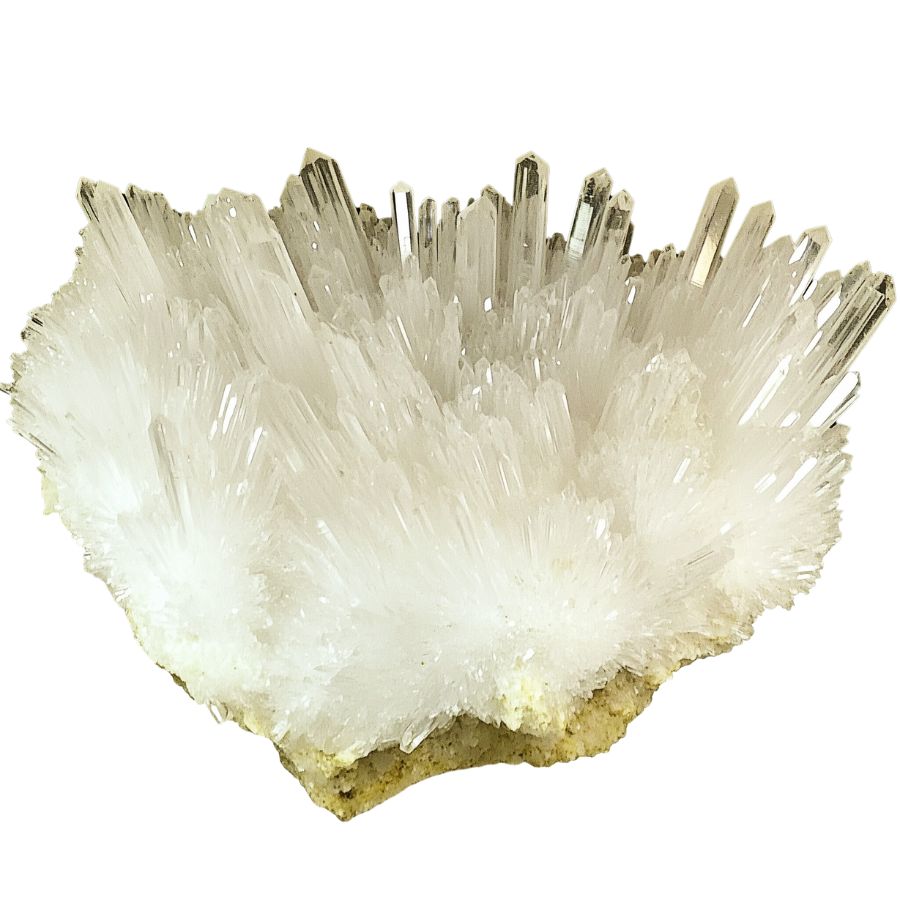
Scolecite geodes are like tiny crystal caves. They’re usually white or colorless, but sometimes you might find pink, yellow, or green ones.
What makes them special is the crystals inside. They look like thin needles or delicate hairs, all pointing out from the center.
These geodes are different from others because of their crystal shape. Instead of blocky or chunky crystals, scolecite has these fine, hair-like ones. This gives them a unique, delicate look.
Scolecite has an interesting property – it can hold a lot of water in its structure. This means it can absorb and release water easily. This makes scolecite useful in various ways, not just as a pretty rock to look at.
Apophyllite Geode
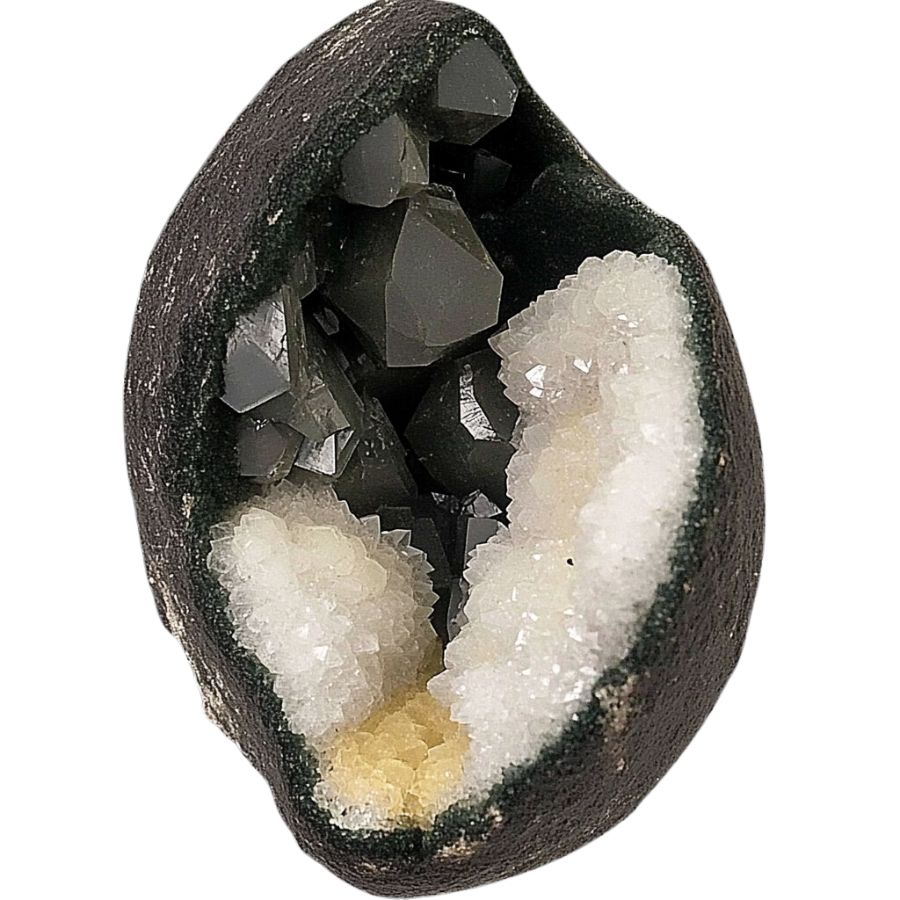
Apophyllite geodes are like nature’s disco balls. They often have dark or black crystals inside a hollow rock. These crystals can be see-through or slightly cloudy, with cube-like or flat shapes.
What makes apophyllite geodes stand out is how the crystals form. They grow in round clusters that look like tiny disco balls. This unique formation is rare and makes them special to rock enthusiasts.
Collectors really prize these “disco ball” clusters. They’re not common, which makes them valuable to people who love unusual rocks. The way apophyllite crystals catch and reflect light adds to their appeal, making them fascinating to look at and study.
What Rough Geode Looks Like
Identifying a rough geode might seem tricky, but with a few tips, you can spot one even if you’re not a rock expert. Here’s how you can do it.
Look for a Rounded Shape
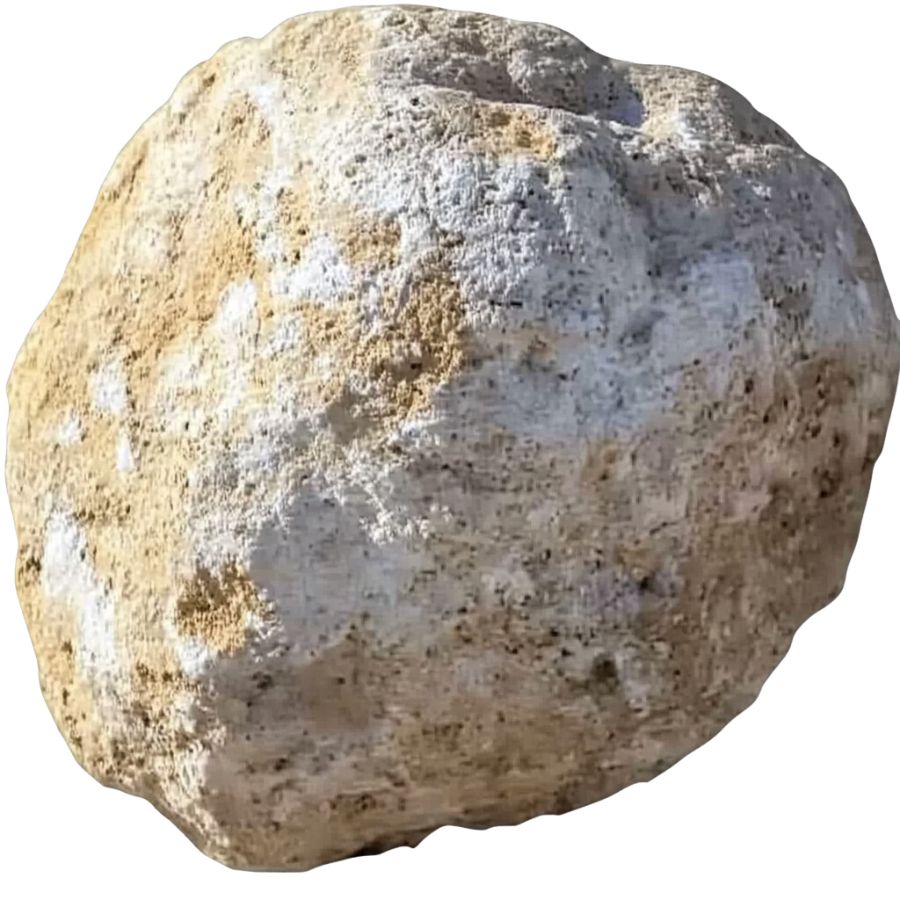
A rough geode often has a rounded or egg-like shape. It might not be perfectly round but look for a generally bulbous form.
When you’re out searching, skip the flat, jagged rocks. Geodes usually have smoother exteriors because they’ve been rolling around in rivers or other environments for a long time.
Check for a Dull, Bumpy Surface
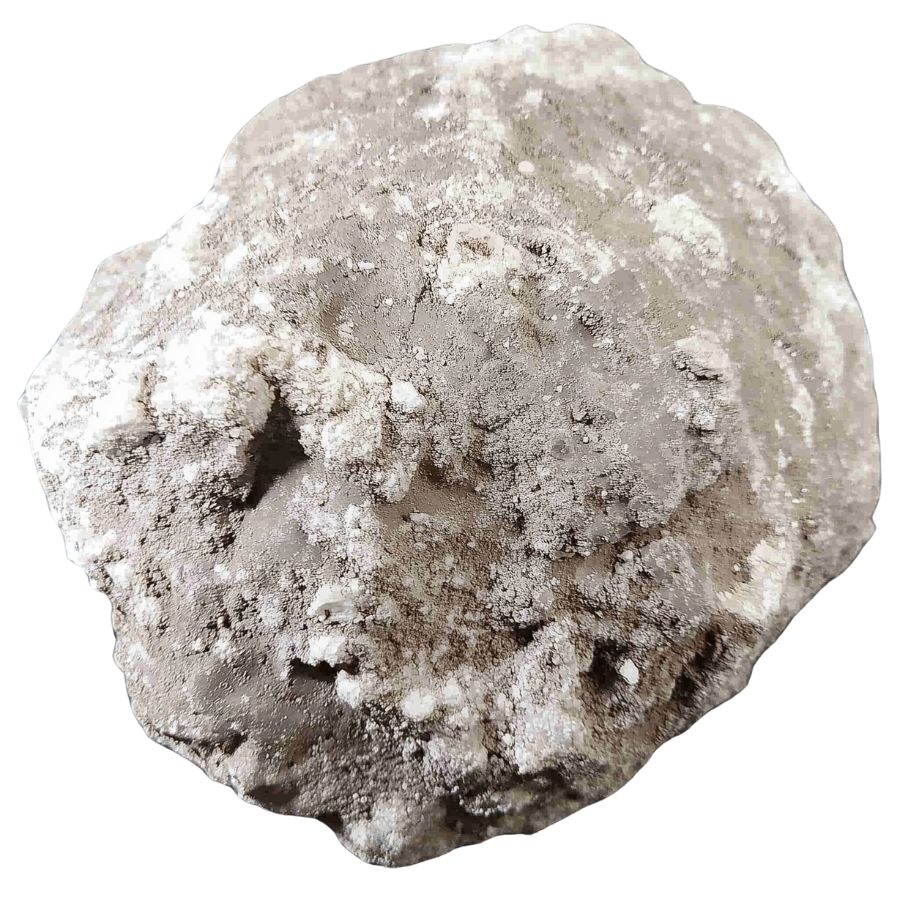
The outside of a geode isn’t usually shiny. Instead, it’s dull, bumpy, and a bit rough.
Imagine a potato or a clump of dirt with some bumps and dents. That’s how a geode might look before it’s cracked open.
The outside won’t give away much of what’s inside, so don’t be fooled by its ordinary appearance.
Test the Weight
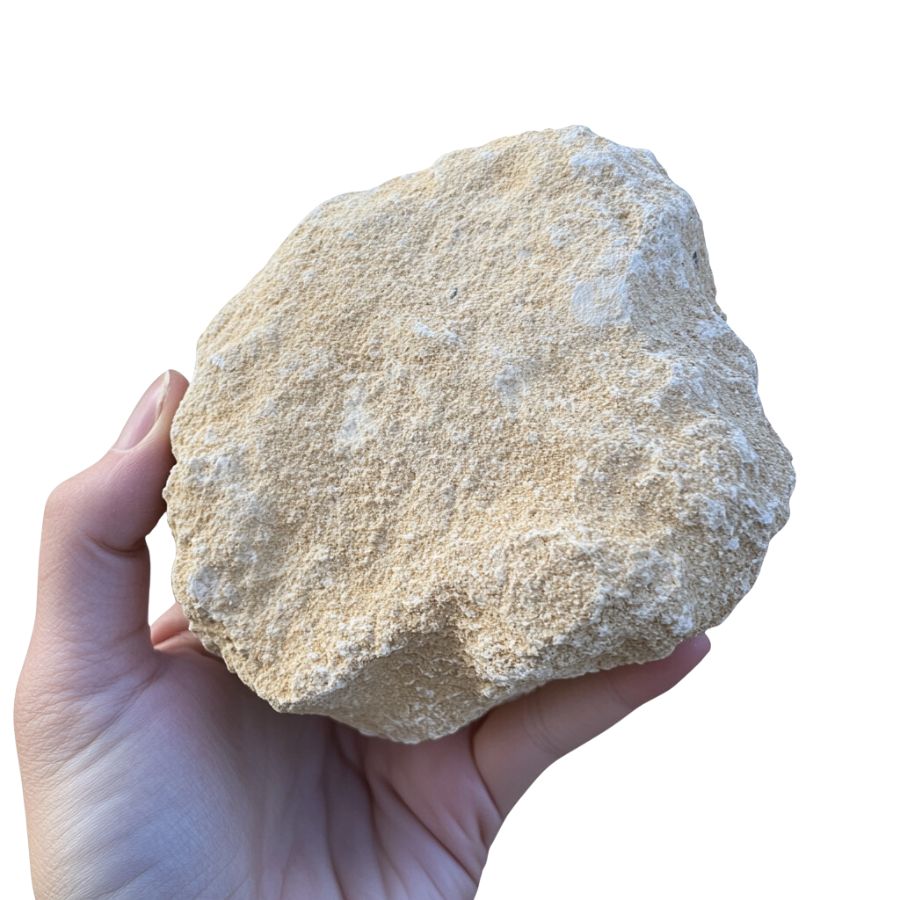
Pick up the rock. Does it feel lighter than it looks? That’s a good sign!
Geodes are hollow or partially hollow, which makes them lighter than solid rocks of the same size. If it feels unexpectedly light, you might have found something special.
Look for Tiny Crystals or Mineral Patches
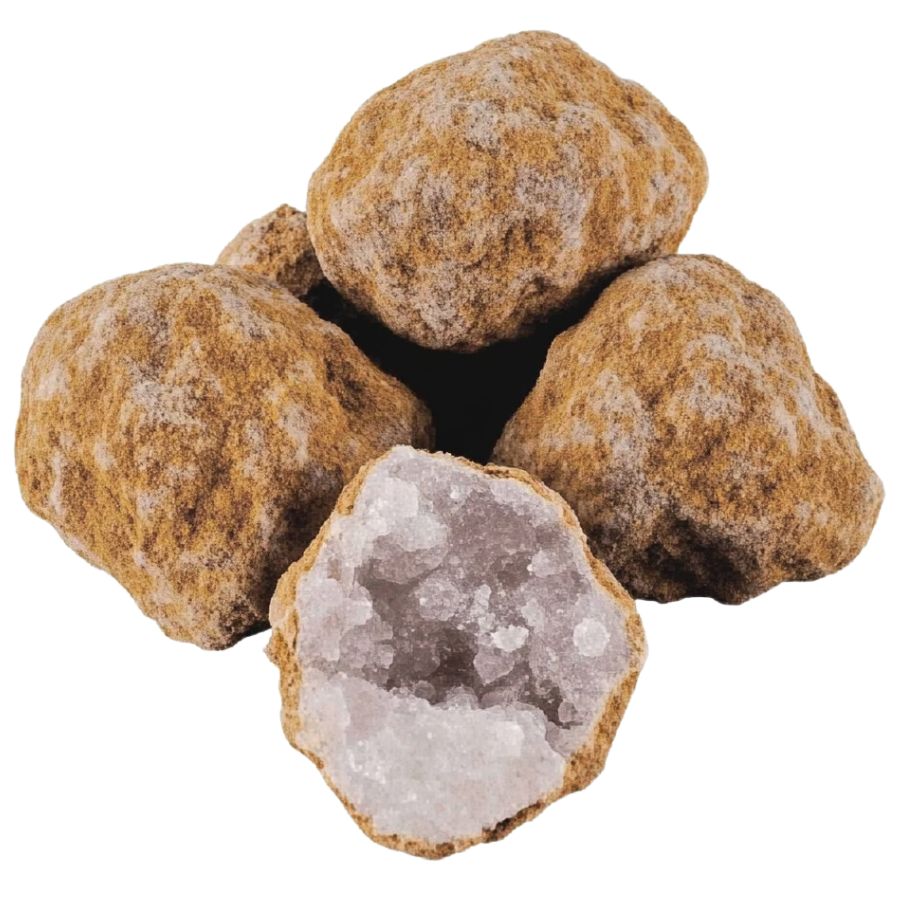
Sometimes, you can spot small crystals or mineral deposits on the outside. These could look like tiny sparkles or specks of color.
While the outside of a geode is usually dull, a little peek of what’s inside might show through. Keep an eye out for these hints, especially if you’re in a known geode-rich area.
Tips on Where to Look
Once you get to the places we have listed below there are some things you should keep in mind when you’re searching:
Explore Riverbeds and Streams
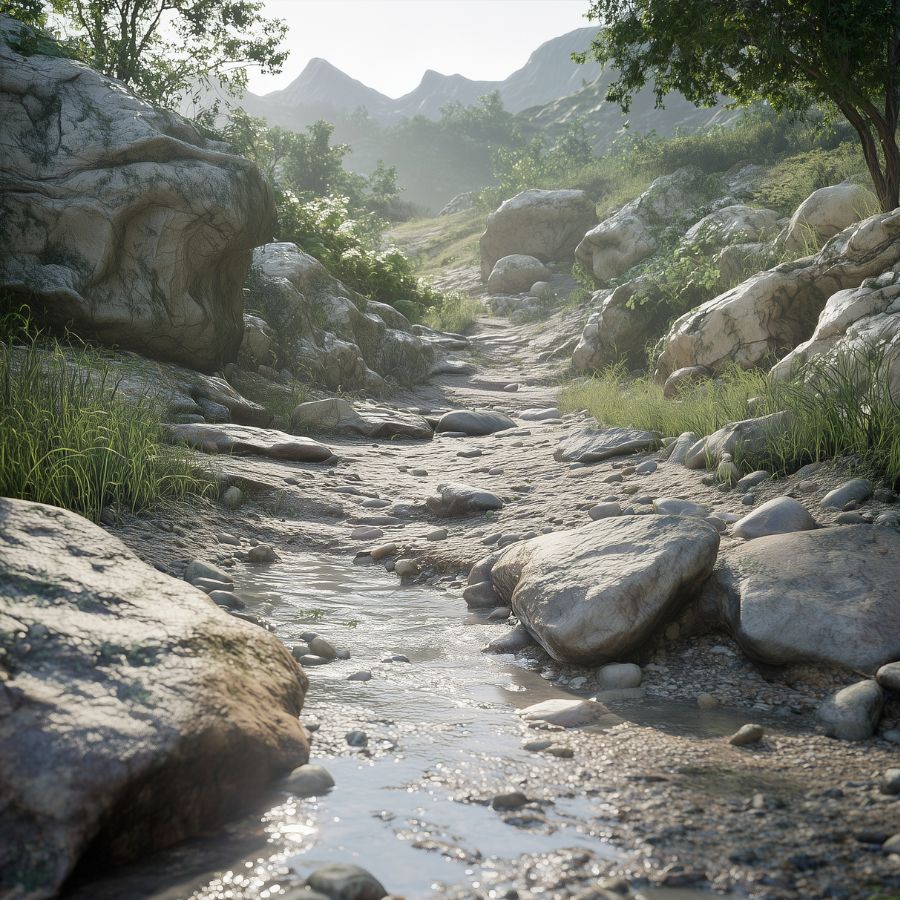
Geodes often form in riverbeds or streams. Water flow smooths out their rough edges and deposits them in these areas.
When exploring, focus on gravel bars or the edges of rivers where rocks naturally gather.
Search in Sedimentary Rock Layers
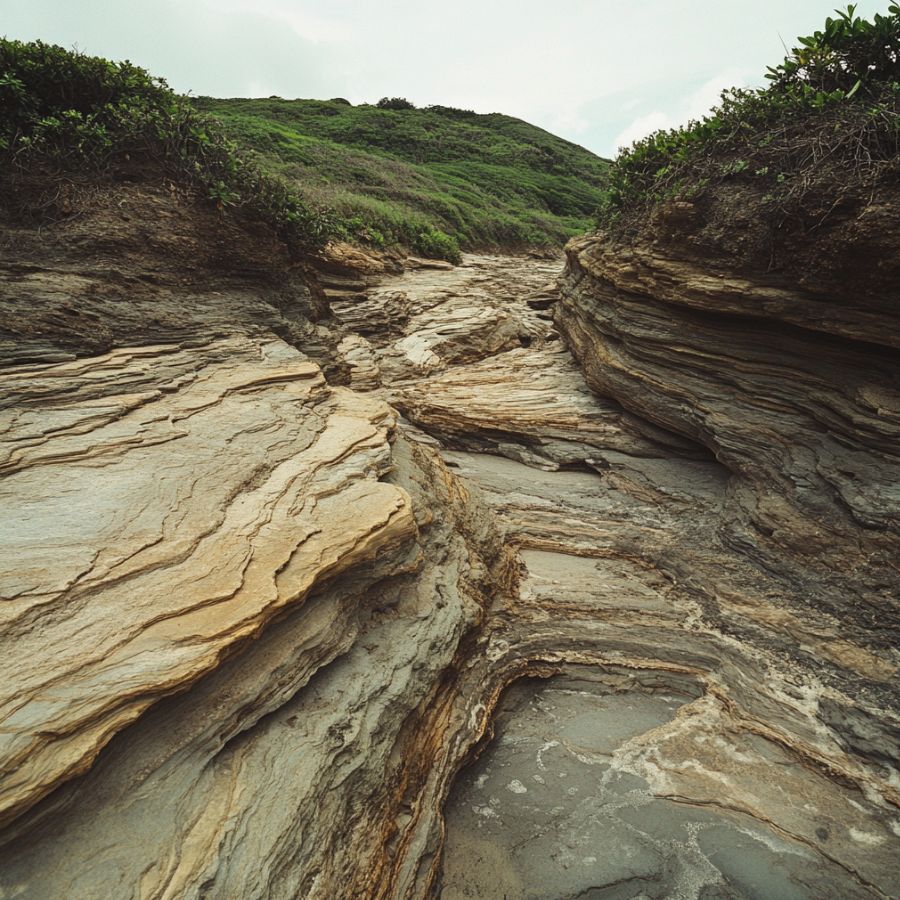
Sedimentary rocks, like limestone, are prime spots for geodes. These rocks form in layers over time, trapping minerals inside.
Look for areas where sedimentary rocks are exposed, such as cliffs or road cuts.
Visit Old Mines or Quarries
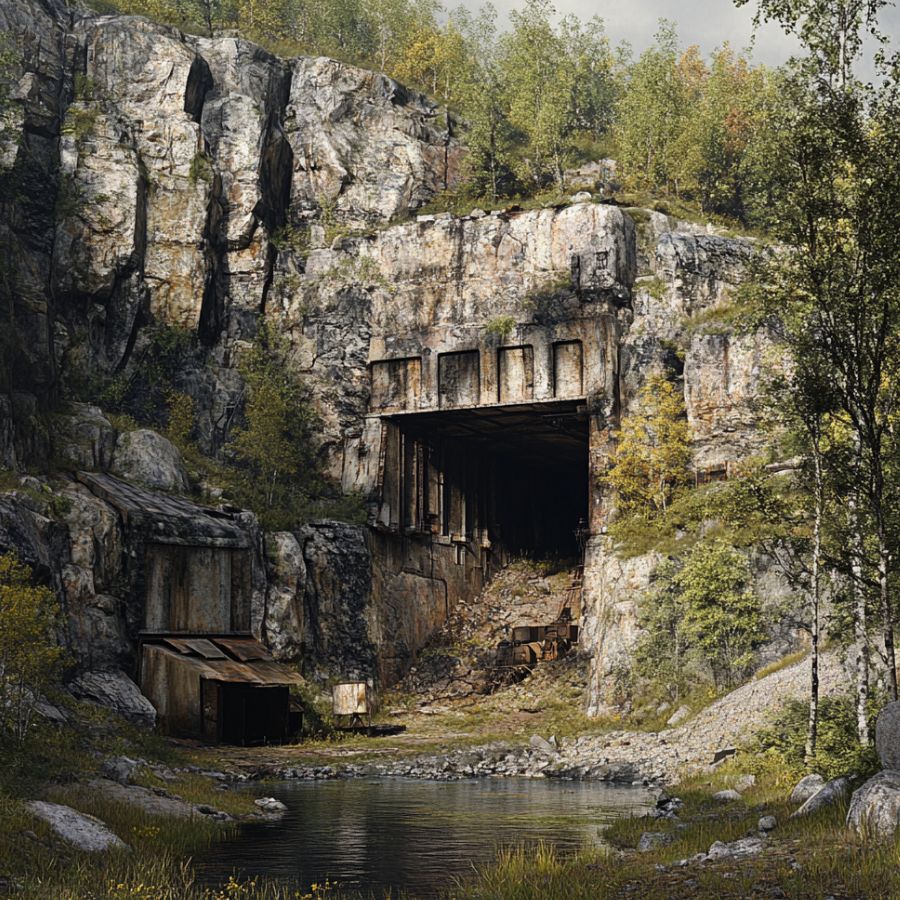
Abandoned mines and quarries are excellent spots for geode hunting.
Workers often missed geodes while digging for other materials. Explore the tailings or leftover rock piles for hidden treasures.
Explore Hills and Rock Outcrops
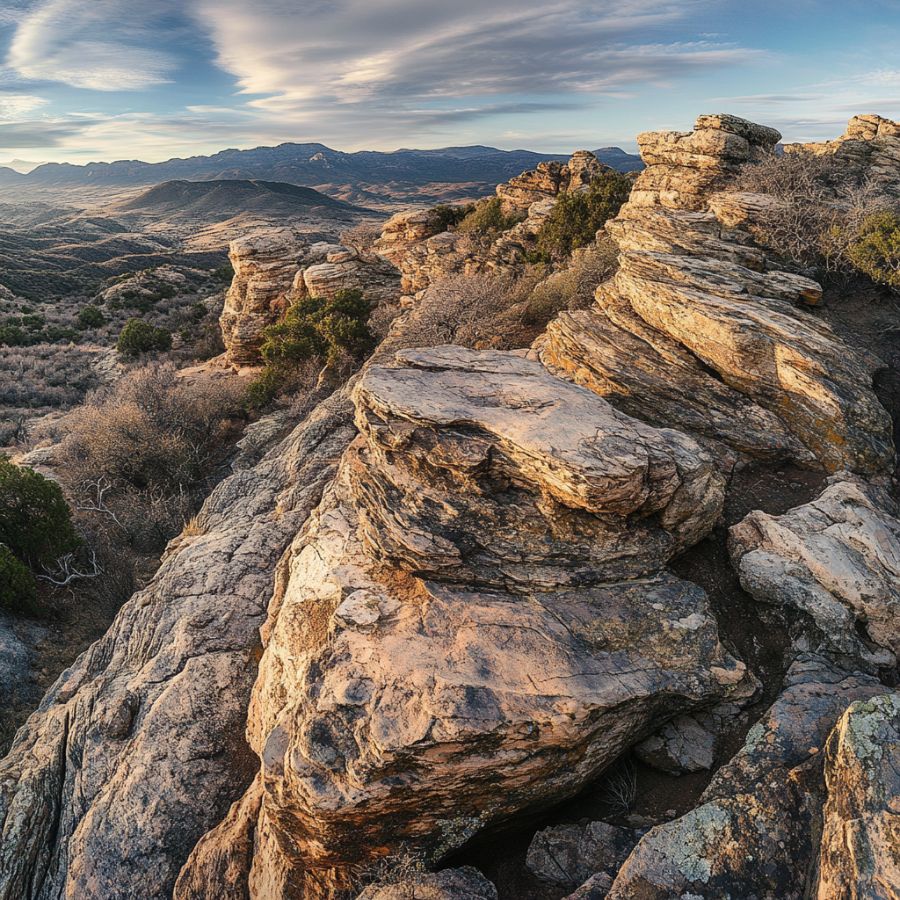
Hills and rocky outcrops often reveal geodes. As erosion wears away the softer rock, it exposes the harder geodes.
Look for areas with exposed rocks and keep an eye out for rounded shapes.
The Types of Geodes You Can Find in Washington
Our state is lucky to have a wide variety of this natural wonder! How much a geode is worth depends on what kind it is. The following are some of the most notable ones you can find here:
- Agate geodes
- Amethyst geodes
- Blue Agate geodes
- Blue Chalcedony geodes
- Chalcedony geodes
The Best Places To Find Geodes in Washington
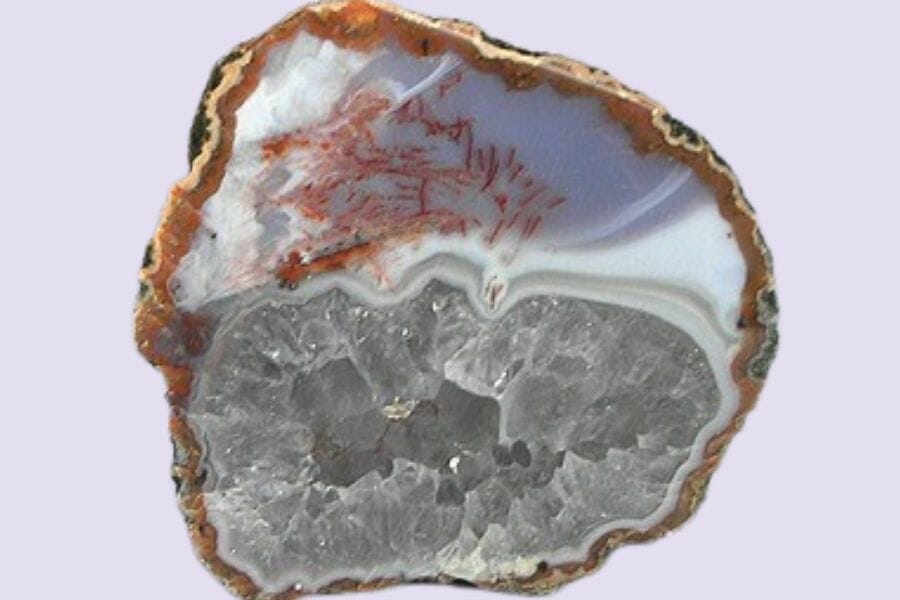
It’s no secret among gem collectors and enthusiasts that there are plenty great places to mine gems in Washington. While those places are definitely rich in gems, not all of them have geodes. That’s why we’re sharing with you the locations where you will surely find geodes in Washington. Are you ready?
Always Confirm Access and Collection Rules!
Before heading out to any of the locations on our list you need to confirm access requirements and collection rules for both public and private locations directly with the location. We haven’t personally verified every location and the access requirements and collection rules often change without notice.
Many of the locations we mention will not allow collecting but are still great places for those who love to find beautiful rocks and minerals in the wild without keeping them. We also can’t guarantee you will find anything in these locations since they are constantly changing.
Always get updated information directly from the source ahead of time to ensure responsible rockhounding. If you want even more current options it’s always a good idea to contact local rock and mineral clubs and groups
Lewis County
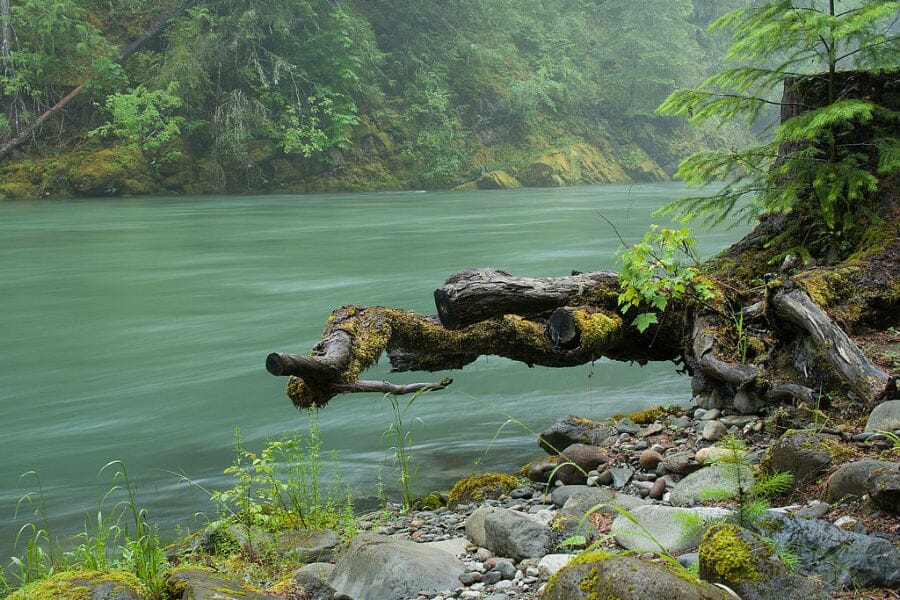
Lewis County, also called the “Gateway to Mount Rainier”, is a diverse place when it comes to geography, terrain, and geology. Everything from rolling hills to rocky mountains, dense forests to open prairies, and even volcanoes are here. Because of this geography, the county has rich reserves of rocks and gems— including geodes!
Getting here isn’t too hard, but it also isn’t a breeze to do so. You will have to drive along narrow, winding roads and hills for a bit. But once you get there, you’ll understand why it’s worth visiting.
And if you’ll go here to hunt for geodes, make sure to check the latest guidelines from the State of Washington.
Where we found geodes at Lewis County
Lewis County has tons of specific areas where you can find geodes. Some of the most prominent ones are the following:
- Newaukum River
- Cowlitz River
- West Adna
- Salmon River
- Centralia
- Chehalis River
- Mary’s Corner
- Pe Ell
- Toledo
DON'T MISS OUT ON ANY GREAT FINDS!
While you're out searching for Geodes you're going to find a lot of other interesting rocks and minerals along the way. The last thing you want to do is toss out something really interesting or valuable. It can be easy to misidentify things without a little guidance.
We've put together a fantastic field guide that makes identifying 140 of the most interesting and valuable rocks and minerals you will find REALLY EASY. It's simple to use, really durable, and will allow you to identify just about any rock and mineral you come across. Make sure you bring it along on your hunt!
Walker Valley Geode Location
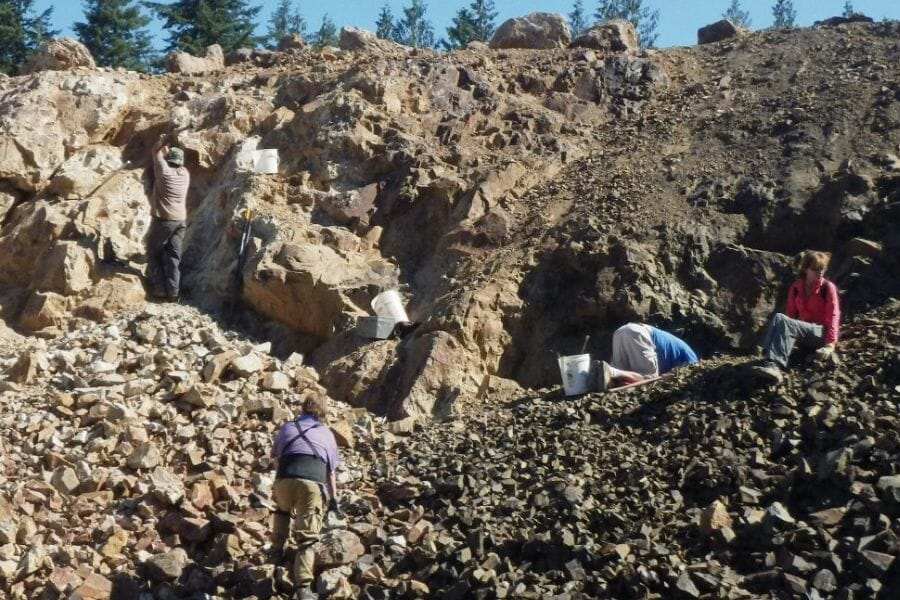
Walker Valley Geode Location is quite popular among those who are into rockhounding and finding geodes. Tucked away in the foothills of the Cascade Mountains, the terrain of this place can be a bit rough, with lots of rocks and boulders to navigate around.
Since Walker Valley Geode Location is situated in an area that’s rich in volcanic activity, you’ll find all sorts of interesting rocks and minerals there. And of course, the main attraction is the geodes!
This place is off the beaten path, but if you’re up for an adventure, it’s definitely worth checking out!
Where we found geodes in Walker Valley Geode Location
About 15 kilometers east of Mount Vernon lies the Walker Valley Geode Location. Since the late 1960s, people have been collecting geodes from the rock formations of this place after an excavation for road construction material uncovered these natural wonders.
Kittitas County
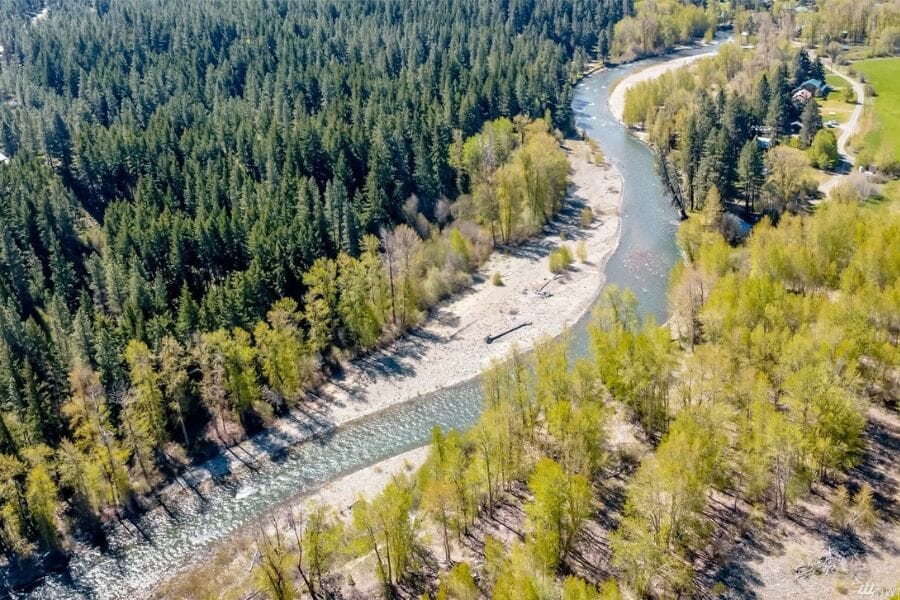
If you’re into outdoor adventure and scenic views, Kittitas County is the place for you! Located in the central part of our state, it’s surrounded by mountains and rolling hills.
Its terrain is pretty diverse, with everything from high alpine meadows to rocky canyons. As for the geology, this county is home to some pretty interesting formations. There’s the Ellensburg Formation, which is made up of ancient volcanic rocks that are over 50 million years old.
So if you’re ever in the area and looking for some fun, Kittitas County is definitely worth a visit! If you’re coming from Seattle or Spokane, just hop on I-90 and you’re off to this amazing place.
Where we found geodes at Kittitas County
Kittitas County abounds in geodes, so if you’re here, chances are you’re near one! But if you’re planning to explore it deeper in search for geodes, the following are some of the best spots to do it:
- Ellensburg formation
- Red Top Mountain and Teanaway Ridge
- Middle Fork Teanaway River
- Liberty area
Ellensburg
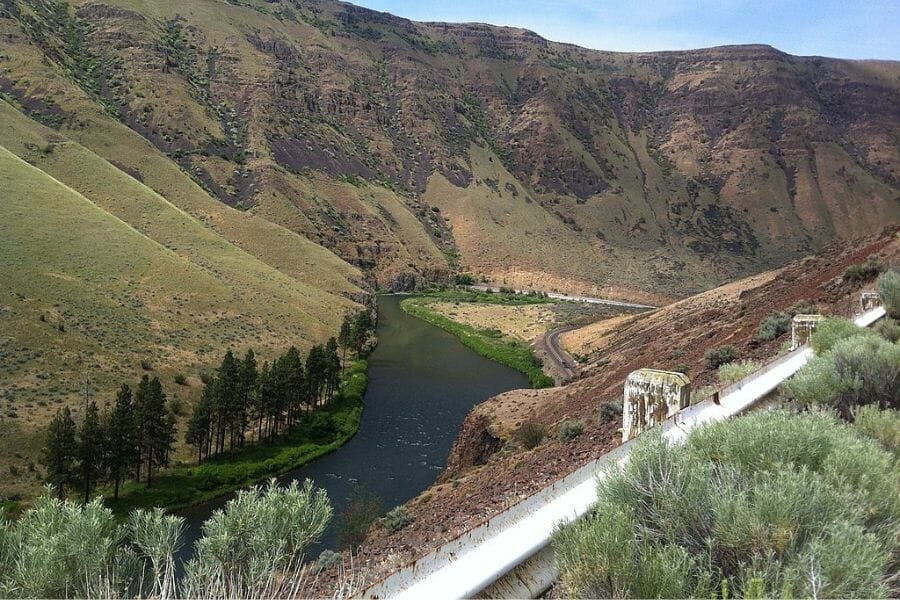
Ellensburg is a charming little town nestled in the foothills of the Cascade Mountains. Its geography is pretty diverse, with everything from rolling hills to towering peaks. Just look at its breathtaking photo!
This place is a bit rugged, with lots of rocky outcroppings and steep cliffs. As for its geology, Ellensburg is home to some pretty interesting formations. There’s the Ellensburg Formation, which is made up of volcanic rocks and sedimentary layers that are millions of years old. It’s known for having the highly-coveted Blue Chalcedony Geodes.
If you’re planning to visit here, hop on I-90 and you’ll be here in no time. So if you’re ever in the area and looking for a fun and interesting place to explore, Ellensburg is worth adding to your itinerary!
Where we found geodes in Ellensburg
The lava flows and weathering out of North Ellensburg is where you can find some of the most amazing geodes, including the sought after Blue Chalcedony Geodes.
Cowlitz County
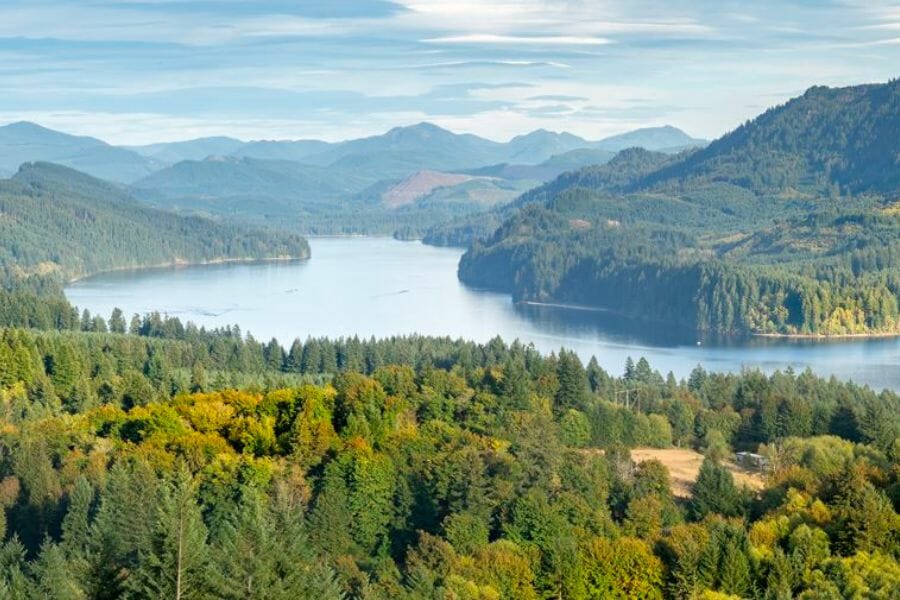
Located in the southwest part of our state, Cowlitz County’s geography is pretty diverse, with lots of rolling hills and lush forests. The Cowlitz River also runs right through the middle of the county.
The terrain here is interesting, with some steep hills and rocky outcroppings. This county is home to some pretty interesting formations. There are also plenty of volcanic rocks and sedimentary layers that are millions of years old.
To go here, hop on I-5 and head south. And rest assured that you won’t run out of great small towns and scenic spots to explore along the way!
Where we found geodes at Cowlitz County
If you want to be sure you’ll find geodes in this county, we recommend exploring the following areas:
- Cemetery Road in Kalama
- Green Mountain Road to Johnson Road
- US-99 (I-5) to Cloverdale
Other Great Places To Dig For Washington Geodes
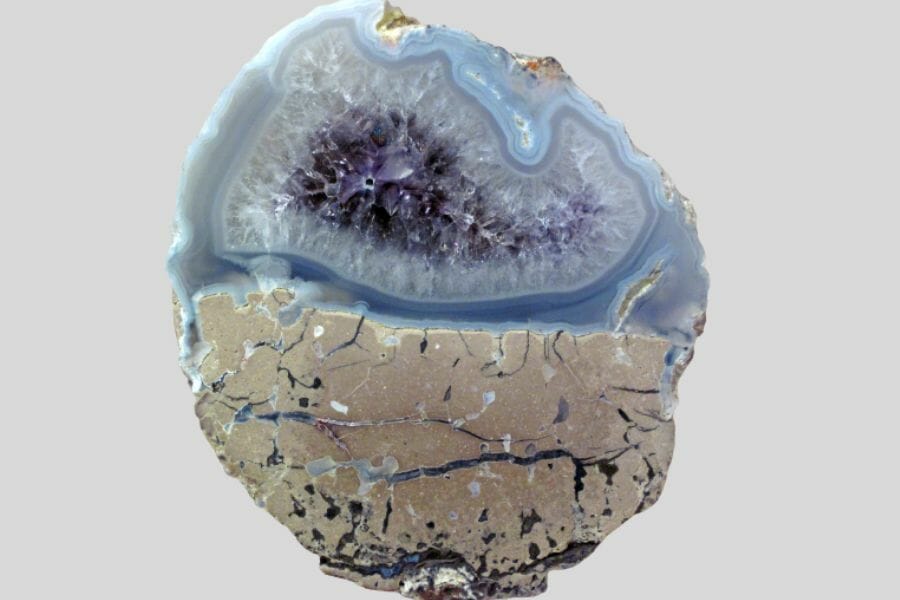
Washington is a treasure trove of geodes, so aside from the places we shared above, there are plenty more that we can recommend to you. We listed them down by county to make it easier for you. For locations where we put, “county wide”, we’ll provide more specific recommendations in the succeeding sections.
Our recommendations by county
| County | Location |
| Chelan | North side of Negro Creek at the Davenport property |
| Cowlitz | County wide |
| Cowlitz | 1.5 miles Northeast on Cemetery Road in Kalama |
| Cowlitz | The east hills of Kalama |
| Cowlitz | 4 miles southeast on Green Mountain Road to Johnson Road |
| Cowlitz | 5 miles north on US-99 (I-5) to Cloverdale |
| Kittitas | County wide |
| Kittitas | In the lava flows and weathering out of North Ellensburg |
| Kittitas | Both sides of road of Red Top Mountain and Teanaway Ridge |
| Kittitas | In gravels of Middle Fork Teanaway River |
| Kittitas | In 2-square mile area of Liberty area |
| Lewis | County wide |
| Lewis | Along Rte. 6 to Lucas Creek at the tributary of the Newaukum River |
| Lewis | Along Lucas Creek tributary of the Cowlitz River at Morton area |
| Lewis | Area road cuts, banks of West Adna |
| Lewis | The regional stream gravels, cut banks of Centralia |
| Lewis | The gravels of the North Fork of the Chehalis River in Doty |
| Lewis | Area farm fields, stream gravels of Mary’s Corner |
| Lewis | Salmon River |
| Lewis | The regional stream banks and gravels of Pe Ell |
| Lewis | The regional stream banks and gravels of Toledo |
| Skagit | County wide |
| Skagit | Walker Valley Geode Location |
| Skagit | 14 miles east and southeast on paved road following Cascade River upstream |
Common Geode-Hunting Questions
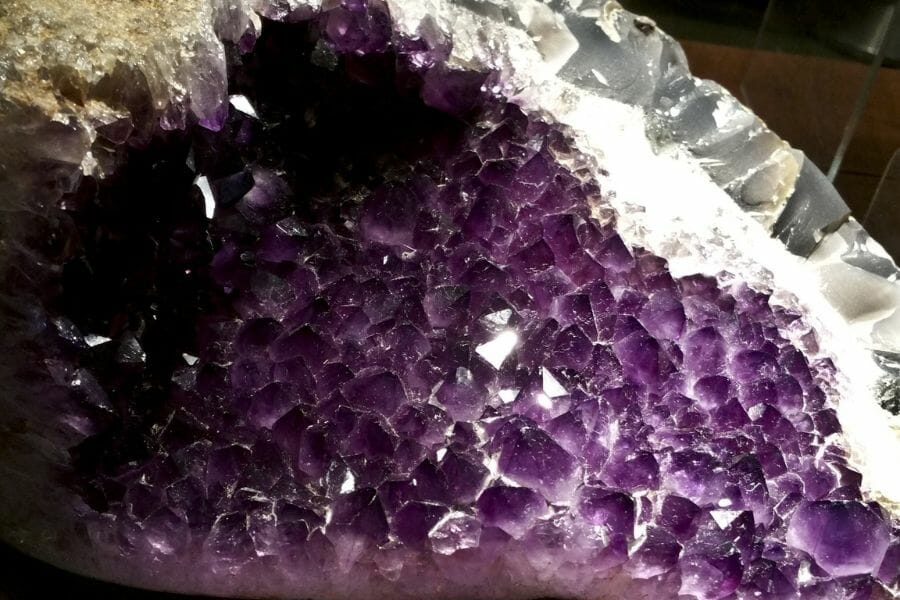
In this section, we’ll quickly answer some of the most common frequently asked questions of enthusiasts and collectors who are planning to find geodes in Washington.
Where can you find amethyst geodes in Washington?
The beauty of amethyst geodes is indeed captivating, so if you’re planning on finding one in Washington, you’re in luck! You can find amethyst geodes when you visit the east hills of Kalama in Cowlitz County.
Is it illegal to collect geodes in Washington?
If you comply with the local collecting laws, you’re good to collect geodes in Washington! Just make sure to follow local regulations for government lands and to get permission first before exploring any private lands here.
The Best Places To Buy Geodes In Washington
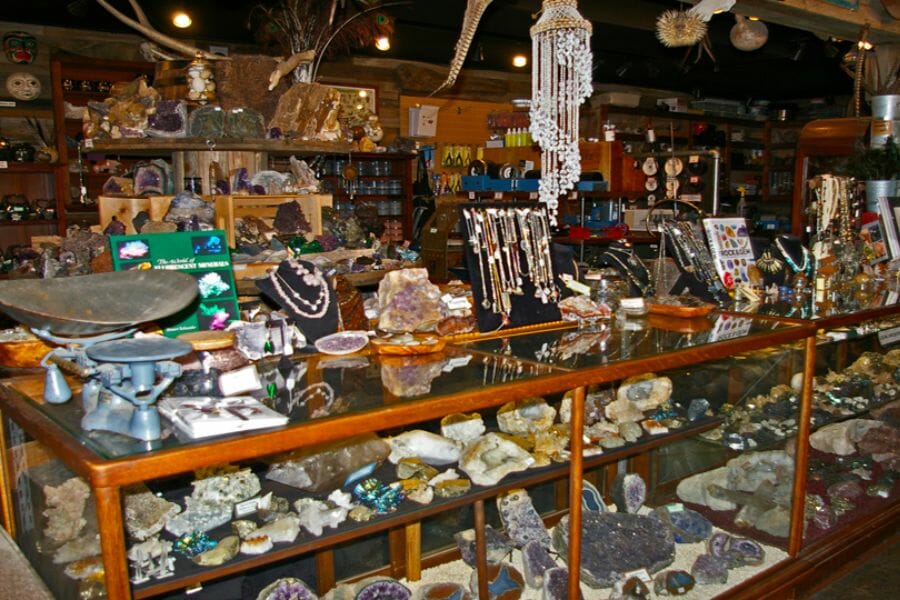
Hours of planning, trekking, and searching for geodes may not be for everyone. So if you want to get your hands on geodes the easier way, we got you!
Here are some of the best local shops where you can purchase geodes:
- NW Rockhounds – 2720 NE 115th St., Seattle, WA 98125
- Amazon – You’ll be surprised at how vast the selections of geodes are on Amazon. You can even find helpful kits to crack them open!
- Agate Designs – 317 NW Gilman Blvd ste 15, Issaquah, WA 98027
- Crystallography Gems – 650 S Orcas St Ste 218, Seattle, WA 98108
- Earthlight Rocks, Gems, and Minerals – 7713 Center Blvd SE #180, Snoqualmie, WA 98065
- Wild Earth Rocks – 11607 State Route 302 NW, Suite B, Gig Harbor, WA 98329
- Magickal Earth – 1522 Cole St, Enumclaw, WA 98022
- J-Cubed Fine Minerals – 1200 Harris Ave Suite 306, Bellingham, WA 98225
- Mystical Wares – 17869 WA-536, Mount Vernon, WA 98273
Additional places to find geodes in nearby states
Check out our guides for nearby states if you’ve already tried all of our suggestions above or if you’re planning a trip outside of the state:
If you have any recommendations for our list please leave a comment below!

